Funny theme by OPTIMUS
Download: Funny_2.p3t
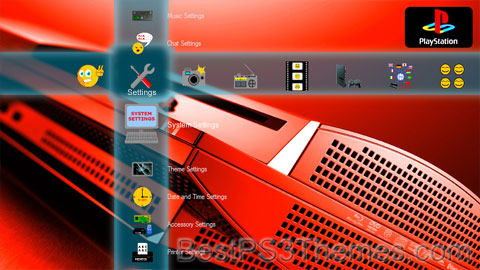
(1 background, different for HD and SD)
Redirect to:
This page is a redirect. The following categories are used to track and monitor this redirect:
|

The #1 spot for Playstation themes!
Funny theme by OPTIMUS
Download: Funny_2.p3t

(1 background, different for HD and SD)
Redirect to:
This page is a redirect. The following categories are used to track and monitor this redirect:
|
Dj BigSmoke theme by BigSmoke
Download: DjBigSmoke.p3t
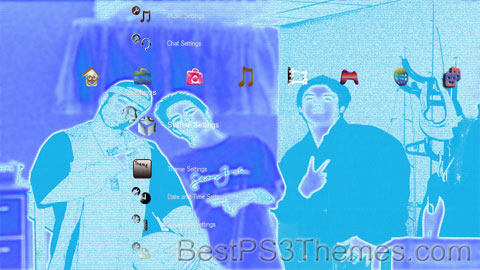
(3 backgrounds)
P3T Unpacker v0.12
Copyright (c) 2007. Anoop Menon
This program unpacks Playstation 3 Theme files (.p3t) so that you can touch-up an existing theme to your likings or use a certain wallpaper from it (as many themes have multiple). But remember, if you use content from another theme and release it, be sure to give credit!
Download for Windows: p3textractor.zip
Instructions:
Download p3textractor.zip from above. Extract the files to a folder with a program such as WinZip or WinRAR. Now there are multiple ways to extract the theme.
The first way is to simply open the p3t file with p3textractor.exe. If you don’t know how to do this, right click the p3t file and select Open With. Alternatively, open the p3t file and it will ask you to select a program to open with. Click Browse and find p3textractor.exe from where you previously extracted it to. It will open CMD and extract the theme to extracted.[filename]. After that, all you need to do for any future p3t files is open them and it will extract.
The second way is very simple. Just drag the p3t file to p3textractor.exe. It will open CMD and extract the theme to extracted.[filename].
For the third way, first put the p3t file you want to extract into the same folder as p3textractor.exe. Open CMD and browse to the folder with p3extractor.exe. Enter the following:
p3textractor filename.p3t [destination path]Replace filename with the name of the p3t file, and replace [destination path] with the name of the folder you want the files to be extracted to. A destination path is not required. By default it will extract to extracted.filename.
Rouge theme by Loic
Download: Rouge.p3t
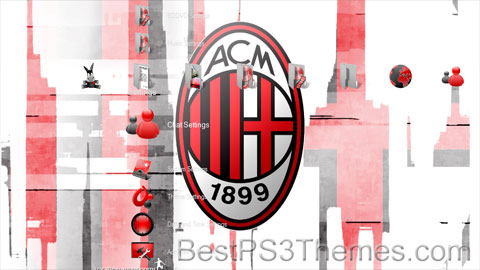
(1 background)
Rouge is the French word for "red" and may refer to:
Carambol theme by corneliu13927
Download: Carambol.p3t
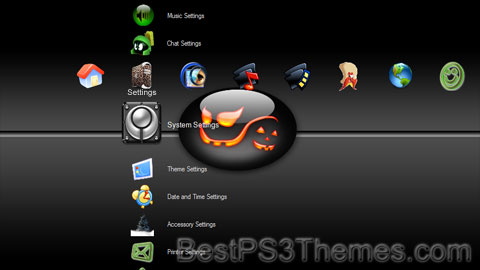
(3 backgrounds)
P3T Unpacker v0.12
Copyright (c) 2007. Anoop Menon
This program unpacks Playstation 3 Theme files (.p3t) so that you can touch-up an existing theme to your likings or use a certain wallpaper from it (as many themes have multiple). But remember, if you use content from another theme and release it, be sure to give credit!
Download for Windows: p3textractor.zip
Instructions:
Download p3textractor.zip from above. Extract the files to a folder with a program such as WinZip or WinRAR. Now there are multiple ways to extract the theme.
The first way is to simply open the p3t file with p3textractor.exe. If you don’t know how to do this, right click the p3t file and select Open With. Alternatively, open the p3t file and it will ask you to select a program to open with. Click Browse and find p3textractor.exe from where you previously extracted it to. It will open CMD and extract the theme to extracted.[filename]. After that, all you need to do for any future p3t files is open them and it will extract.
The second way is very simple. Just drag the p3t file to p3textractor.exe. It will open CMD and extract the theme to extracted.[filename].
For the third way, first put the p3t file you want to extract into the same folder as p3textractor.exe. Open CMD and browse to the folder with p3extractor.exe. Enter the following:
p3textractor filename.p3t [destination path]Replace filename with the name of the p3t file, and replace [destination path] with the name of the folder you want the files to be extracted to. A destination path is not required. By default it will extract to extracted.filename.
Oakland Raiders theme by acm
Download: OaklandRaiders.p3t
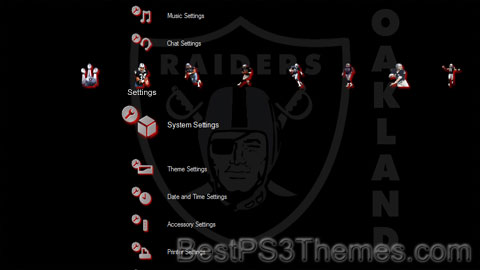
(1 background)
| Oakland Raiders | |||
|---|---|---|---|
| Established 1960 Ended 2019 Played in Oakland, California Headquartered in Alameda, California | |||
| |||
| League/conference affiliations | |||
American Football League (1960–1969)
National Football League (1970–2019)
| |||
Uniform | |||
| Team colors | Silver, black | ||
| Fight song | The Autumn Wind | ||
| Mascot | Raider Rusher | ||
| Personnel | |||
| Owner(s) | Chet Soda (1960) F. Wayne Valley (1961–1971) Ed McGah (1966–1971) Co-Owner Al Davis (1966–2011) Mark Davis (2011–Present) | ||
| General manager | Chet Soda (1960) Paul Hastings (1961) Wes Fry (1962) Al Davis (1963–2010) Hue Jackson (2011) Reggie McKenzie (2012–2018) Mike Mayock (2019) | ||
| Head coach | Eddie Erdelatz (1960–1961) Marty Feldman (1961–1962) Red Conkright (1962) Al Davis (1963–1965) John Rauch (1966–1968) John Madden (1969–1978) Tom Flores (1979–1981) Mike White (1995–1996) Joe Bugel (1997) Jon Gruden (1998–2001) Bill Callahan (2002–2003) Norv Turner (2004–2005) Art Shell (2006) Lane Kiffin (2007–2008) Tom Cable (2008–2010) Hue Jackson (2011) Dennis Allen (2012–2014) Tony Sparano (2014) Jack Del Rio (2015–2017) Jon Gruden (2018–2019) | ||
| Team history | |||
| |||
| Team nicknames | |||
| |||
| Championships | |||
League championships (2†)
| |||
| Conference championships (3) | |||
| Division championships (12) † – Does not include the AFL or NFL championships won during the same seasons as the AFL–NFL Super Bowl championships prior to the 1970 AFL–NFL merger | |||
| Playoff appearances (15) | |||
| Home fields | |||
| |||
| This article is part of series of |
| Las Vegas Raiders history |
|---|
| Oakland Raiders (1960–1981) |
| Los Angeles Raiders (1982–1994) |
| Oakland Raiders (1995–2019) |
| Relocation to Las Vegas |
| Las Vegas Raiders (2020–present) |
| List of seasons |
The Oakland Raiders were a professional American football team that played in Oakland from its founding in 1960 to 1981 and again from 1995 to 2019 before relocating to the Las Vegas metropolitan area where they now play as the Las Vegas Raiders. Between 1982 and 1994, the team played in Los Angeles as the Los Angeles Raiders.
The team's first home game was at Kezar Stadium in San Francisco, against the Houston Oilers on September 11, 1960, with a 37–22 loss. They played their last game as an Oakland-based team on December 29, 2019, a game which they lost 16–15 to make them finish 3rd in the AFC West, eliminate them from playoff contention, and suffer a late-season collapse after starting with a 6–4 record.

A few months after the inaugural American Football League draft in 1959, the owners of the yet-unnamed Minneapolis franchise accepted an offer to join the established National Football League as an expansion team (now called the Minnesota Vikings) in 1961, sending the AFL scrambling for a replacement.[2][3] At the time, Oakland seemed an unlikely venue for a professional football team. The city had not asked for a team, there was no ownership group and there was no stadium in Oakland suitable for pro football (the closest stadiums were in Berkeley and San Francisco) and there was already a successful NFL franchise in the Bay Area in the San Francisco 49ers. However, the AFL owners selected Oakland after Los Angeles Chargers owner Barron Hilton threatened to forfeit his franchise unless a second team was placed on the West Coast.[4] Accordingly, the city of Oakland was awarded the eighth AFL franchise on January 30, 1960, and the team inherited the Minneapolis club's draft picks.
Upon receiving the franchise, a meeting of local civic leaders and businessmen was called, chaired by former United States Senator William Fife Knowland, editor of the Oakland Tribune; Edgar Kaiser of Kaiser Steel; developer Robert T. Nahas; and Oakland City Councilman Robert Osborne. Also attending the meeting were Oakland Mayor Clifford E. Rishell; City Councilmen Frank J. Youell, Felix Chialvo, Glenn E. Hoover, Fred Maggiora, John C. Houlihan, Dan Marovich, and Howard E. Rilea; Alameda County Board of Supervisors President Kent D. Pursel; and County Supervisors Emanuel P. Razeto, Leland W. Sweeney, and Francis Dunn. The gathering found a number of businessmen willing to invest in the new team. A limited partnership was formed to own the team headed by managing general partner Y. Charles (Chet) Soda, a local real estate developer, and included general partners Ed McGah, Oakland City Councilman Robert Osborne, F. Wayne Valley, restaurateur Harvey Binns, 1928 Olympic gold medalist Donald Blessing, and contractor Charles Harney, the builder of San Francisco's Candlestick Park, built on a bleak parcel of land he owned; the road leading to the stadium is known as Harney Way.
A "name the team" contest was held by the Oakland Tribune, and the winner was announced April 4, 1960, as the Oakland Señors.[5] After a few days of being the butt of local jokes (and accusations that the contest was fixed, as Soda was fairly well known within the Oakland business community for calling his acquaintances "señor"), the fledgling team (and its owners) changed the team's name nine days later[6] to the Oakland Raiders, which had finished third in the naming contest.[7] The original team colors were black, gold and white. The now-familiar team emblem of a pirate (or "raider") wearing a football helmet was created, reportedly a rendition of actor Randolph Scott.[8]
Oakland Raiders games were broadcast locally on KNBC (680 AM; the station later became KNBR), with Bud (Wilson Keene) Foster handling play-by-play and Mel Venter providing color analysis. Foster, the "Voice of the California Golden Bears", had a long career in radio, 1945–1955 as the "Voice of the Oakland Oaks" of the defunct Pacific Coast League; Foster was the first 1946–1949, 1951–1953, "Voice of the San Francisco 49ers".[9] After the 1962 season, Foster would only call CAL (University of California at Berkeley) football until his retirement. Raider games, 1963–1965 were heard on KDIA 1410 AM, with Bob Blum and Dan Galvin. In 1966. KGO Radio 810 signed a contract with the Oakland Raiders. Bill King was hired for the play-by-play and Scotty Stirling (an Oakland Tribune sportswriter) was color commentator.
When the University of California refused to let the Raiders play home games at Memorial Stadium in Berkeley, they chose Kezar Stadium in San Francisco as their home field. The team's first regular season home game was played on September 11, 1960, a 37–22 loss to the Houston Oilers.
The Raiders were allowed to move to Candlestick Park for the final three home games of the 1960 season after gaining the approval of San Francisco's Recreation and Park Commission, marking the first time that professional football would be played at the new stadium.[10] The change of venue, however, failed to attract larger crowds for the Raiders during their time at Candlestick Park, with announced attendance of 12,061 (vs. the Chargers in a 41–17 loss on December 4), 9,037 (vs. the New York Titans in a 31–28 loss on December 11) and 7,000 (estimated, vs. the Broncos in a 48–10 victory to close out the season on December 17) at Candlestick.
The Raiders finished their first campaign with a 6–8 record, and lost $500,000, equivalent to $5.15 million in 2023. Desperately in need of money to continue running the team, Valley received a $400,000 loan from Buffalo Bills founder Ralph Wilson, equivalent to $4.12 million in 2023.[11]
After the conclusion of the first season Soda dropped out of the partnership, and on January 17, 1961, Valley, McGah and Osborne bought out the remaining four general partners. Soon after, Valley and McGah purchased Osborne's interest, with Valley named as the managing general partner. After splitting the previous home season between Kezar and Candlestick, the Raiders moved exclusively to Candlestick Park in 1961, where total attendance for the season was about 50,000, and finished 2–12. Valley threatened to move the Raiders out of the area unless a stadium was built in Oakland, but in 1962 the Raiders moved into 18,000-seat Frank Youell Field (later expanded to 22,000 seats), their first home in Oakland.[12] It was a temporary home for the team while the Oakland–Alameda County Coliseum was under construction. Under Marty Feldman and Red Conkright—the team's second and third head coaches since entering the AFL—the Raiders finished 1–13 in 1962, losing their first 13 games (and making for a 19–game losing streak from 1961 and 1962) before winning the season finale, and attendance remained low.
After the 1962 season, Valley hired Al Davis, a former assistant coach of the San Diego Chargers, as head coach and general manager. At 33, he was the youngest person in over 30 years to hold the position of head coach, and the youngest person ever to hold the position of general manager, in professional football.[13] Davis immediately changed the team colors to silver and black, and began to implement what he termed the "vertical game", an aggressive offensive strategy based on the West Coast offense developed by Chargers head coach Sid Gillman.[14] Under Davis the Raiders improved to 10–4, and he was named the AFL's Coach of the Year in 1963. Though the team slipped to 5–7–2 in 1964, it rebounded to an 8–5–1 record in 1965. He also initiated the use of team slogans such as "Pride and Poise", "Commitment to Excellence", and "Just Win, Baby"—all of which are registered trademarks.[15][16][17]
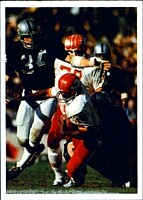
In April 1966, Davis left the Raiders after being named AFL Commissioner. Two months later, the league announced its merger with the NFL. With the merger, the position of commissioner was no longer needed, and Davis entered into discussions with Valley about returning to the Raiders. On July 25, 1966, Davis returned as part-owner of the team. He purchased a 10 percent interest in the team for US$18,000, equivalent to $169,034 in 2023, and became the team's third general partner—the partner in charge of football operations.[18][19]
On the field, the team Davis had assembled and coached steadily improved. With John Rauch (Davis's hand-picked successor) as head coach, the Raiders won the 1967 AFL Championship, defeating the Houston Oilers 40–7. The win earned the team a trip to Super Bowl II, where they were beaten 33–14 by Vince Lombardi's Green Bay Packers. The following two years, the Raiders again won Western Division titles, only to lose the AFL Championship to the eventual Super Bowl winners—the New York Jets (1968) and Kansas City Chiefs (1969).
In 1969, John Madden became the team's sixth head coach, and under him the Raiders became one of the most successful franchises in the NFL, winning six division titles during the 1970s. It was during this period that the Raiders forged an image as a team of tough, take-no-prisoners players—such as future Hall of Fame offensive linemen Jim Otto, Gene Upshaw, and Art Shell; linebacker Ted ("the Stork") Hendricks; defensive end Ben Davidson; and cornerback Willie Brown—who would occasionally cross the line into dirty play. Those teams also featured an additional foursome of future Hall of Fame players in tight end Dave Casper, kicker George Blanda, and wide receiver Fred Biletnikoff, as well as fiery quarterback Ken ("the Snake") Stabler.[20]
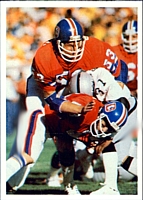
In 1970, the AFL–NFL merger took place and the Raiders became part of the Western Division of the American Football Conference in the newly merged NFL. The first post-merger season saw the Raiders win the AFC West with an 8–4–2 record and go all the way to the conference championship, where they lost to the Colts. Despite another 8–4–2 season in 1971, the Raiders failed to win the division or achieve a playoff berth.
In 1972, with Wayne Valley out of the country for several weeks attending the Olympic Games in Munich, Davis's attorneys drafted a revised partnership agreement that gave him total control over all of the Raiders' operations. McGah, a supporter of Davis, signed the agreement. Under partnership law, by a 2–1 vote of the general partners, the new agreement was thus ratified. Valley was furious when he discovered this, and immediately filed suit to have the new agreement overturned, but the court sided with Davis and McGah. That year would see the team achieve a 10–3–1 record and another division title. In the divisional round of the playoffs, they were beaten by the Steelers 13–7 on a play that would later be known as the Immaculate Reception.
With a record of 9–4–1 in 1973, the Raiders reached the AFC Championship, but lost 27–10 to the Dolphins.
In 1974, Oakland had a 12–2 regular season, which included a nine-game winning streak. They beat the Dolphins in the divisional round of the playoffs in a see-saw battle before falling to the Steelers in the AFC Championship. The playoff game against the Dolphins is known in NFL lore as the Sea of Hands game in which running back Clarence Davis caught a late 4th-quarter touchdown amid three Miami defenders to win 28–26 and end the Dolphins' chances of a three-peat and a fourth consecutive Super Bowl appearance.

In the 1975 season opener, the Raiders beat Miami and ended the Dolphins' 31-game home winning streak. With an 11–3 record, they defeated Cincinnati in the divisional playoff round, but again fell to the Steelers in the conference championship.
In 1976, Valley sold his interest in the team, and Davis—who now owned only 25 percent of the Raiders—was firmly in charge.[18][21] The Raiders beat Pittsburgh in a revenge match on the season opener and continued to cement their reputation for hard, dirty play by knocking WR Lynn Swann out for two weeks in a helmet-to-helmet collision. Al Davis later tried to sue Steelers coach Chuck Noll for libel after the latter called safety George Atkinson a criminal for the hit. The Raiders won 13 regular season games and a close victory over New England (the only team to beat them in the regular season) in the first round of the playoffs. They then knocked out the injury-plagued Steelers in the AFC Championship to go to Super Bowl XI. Oakland's opponent was the Minnesota Vikings, a team that had lost three previous Super Bowls. The Raiders led 16–0 at halftime. By the end, forcing their opponent into multiple turnovers, they won 32–14 for their first post-merger championship.
The following season saw the Raiders finish 11–3, but lose the division title to 12–2 Denver. They settled for a wild card playoff berth, beating the
CBE Clan theme by Mondo7 Download: CBEClan.p3t P3T Unpacker v0.12 This program unpacks Playstation 3 Theme files (.p3t) so that you can touch-up an existing theme to your likings or use a certain wallpaper from it (as many themes have multiple). But remember, if you use content from another theme and release it, be sure to give credit! Download for Windows: p3textractor.zip Instructions: Download p3textractor.zip from above. Extract the files to a folder with a program such as WinZip or WinRAR. Now there are multiple ways to extract the theme. The first way is to simply open the p3t file with p3textractor.exe. If you don’t know how to do this, right click the p3t file and select Open With. Alternatively, open the p3t file and it will ask you to select a program to open with. Click Browse and find p3textractor.exe from where you previously extracted it to. It will open CMD and extract the theme to extracted.[filename]. After that, all you need to do for any future p3t files is open them and it will extract. The second way is very simple. Just drag the p3t file to p3textractor.exe. It will open CMD and extract the theme to extracted.[filename]. For the third way, first put the p3t file you want to extract into the same folder as p3textractor.exe. Open CMD and browse to the folder with p3extractor.exe. Enter the following: Ratchet and Clank theme by Rikard Carlsson Download: RatchetandClank_3.p3t Redirect to: Grand Theft Auto IV theme by Cheetah710 Download: GTAIV_10.p3t
Grand Theft Auto IV is a 2008 action-adventure game developed by Rockstar North and published by Rockstar Games. It is the sixth main entry in the Grand Theft Auto series, following 2004's Grand Theft Auto: San Andreas, and the eleventh entry overall. Set in the fictional Liberty City, based on New York City, the single-player story follows Eastern European war veteran Niko Bellic and his attempts to escape his past while under pressure from high-profile criminals. The open world design lets players freely roam Liberty City, consisting of three main islands, and the neighbouring state of Alderney, which is based on New Jersey.
The game is played from a third-person perspective and its world is navigated on foot and by vehicle. Throughout the single-player mode, players control Niko Bellic. An online multiplayer mode is also included with the game, allowing up to 32 players to engage in both cooperative and competitive gameplay in a recreation of the single-player setting.[b] Two expansion packs were later released for the game, The Lost and Damned and The Ballad of Gay Tony, which both feature new plots that are interconnected with the main Grand Theft Auto IV storyline, and follow new protagonists.
Development of Grand Theft Auto IV began soon after the release of San Andreas and was shared between many of Rockstar's studios worldwide. The game introduced a shift to a more realistic and detailed style and tone for the series. Unlike previous entries, Grand Theft Auto IV lacked a strong cinematic influence, as the team attempted an original approach to the story. As part of their research for the open world, the development team conducted extensive field research in New York, capturing over 100,000 photographs and several hours of video. The developers considered the world to be the most important element of the game; though not the largest map in the series, they considered it comparable in scope due to its verticality and level of detail. The budget climbed to over US$100 million, making it one of the most expensive video games to develop.
Grand Theft Auto IV was released for the PlayStation 3 and Xbox 360 consoles in April 2008, and for Windows in December. Upon release, the game received critical acclaim, with praise particularly directed at the narrative and open-world design. Grand Theft Auto IV broke industry sales records and became the fastest-selling entertainment product in history at the time, earning US$310 million in its first day and US$500 million in its first week. Considered one of the most significant titles of the seventh generation of video games, and by many critics as one of the greatest video games of all time, it won year-end accolades, including Game of the Year awards from several gaming publications. It is among the best-selling video games with over 25 million copies sold by 2013. The game generated controversy, with criticism directed at the game's depiction of violence and players' ability to drink-drive. Its successor, Grand Theft Auto V, was released in September 2013.
Grand Theft Auto IV is an action-adventure game played from a third-person perspective.[2] Players complete missions—linear scenarios with set objectives—to progress through the story. It is possible to have several active missions running at one time, as some require players to wait for further instructions or events. Outside of missions, players can freely roam the game's open world and complete optional side missions.[3] Composed of the fictional city of Liberty City, the world is larger in area than most earlier Grand Theft Auto series entries.[4] At the beginning of the game, players can only explore the first island—composed of Dukes and Broker—with all other islands unlocking as the story progresses.[5]
Players use melee attacks, firearms and explosives to fight enemies, and may run, jump, swim or use vehicles to navigate the game's world. There is a first-person perspective option when using vehicles. In combat, auto-aim and a cover system can be used as assistance against enemies. Should players take damage, their health meter can be fully regenerated by consuming food or drinks, using medical kits, or calling for paramedics.[6] If players commit crimes, the game's law enforcement agencies may respond as indicated by a "wanted" meter in the head-up display (HUD). On the meter, the displayed stars indicate the current wanted level (for example, at the maximum six-star level, efforts by law enforcement to incapacitate players become very aggressive). Law enforcement officers will search for players who leave the wanted vicinity. The wanted meter enters a cool-down mode and eventually recedes when players are hidden from the officers' line of sight.[7]
The game's cover system allows players to move between cover, to fire blindly, aim freely, and target a specific enemy. Individual body parts can also be targeted.[8] Melee attacks include additional moves, such as dodging, blocking, disarming an opponent and counter-attacking. Body armour can be used to absorb gunshots and explosive damage, but is used up in the process. When health is entirely depleted, gameplay stops, and players respawn at the nearest hospital.[6]
The single-player mode lets players control an Eastern European war veteran, Niko Bellic. During the story, Niko meets and befriends various new characters. They can then perform favours for Niko whenever he asks; for example, his cousin Roman, who owns a taxi service, can send one of his cabs to take Niko to any destination around the city. Cabs are always available during gameplay for quick travel to a destination. Throughout the course of the game, players are also faced with morality choices, which alter the storyline appropriately depending on the player's choice. While free roaming the game world, players may engage in context-specific activities such as bowling or darts. Other available activities include a vigilante mini-game, and in-game television programming.[9][10][11] Niko has a cell phone for contacting friends and starting activities.[12] The cell phone is also used to access the game's online multiplayer mode, and to enter cheat codes.[13] To access the in-game Internet, which allows Niko to send and receive emails and set up prospective dates with potential girlfriends, Niko can use Internet cafés located around the city.[14] The game also features a subway system, allowing players to quickly traverse through the game's world.[15]
The online multiplayer mode for Grand Theft Auto IV allows up to 32 players[b] to freely roam across the map. Players decide which game mode they wish to play, including deathmatches and street races. Both cooperative and competitive game modes are available, split into ranked and unranked matches.[16] For players to level up through ranks, in-game money has to be earned. The game also features a Free Mode, in which players have the entire map open to explore, with no end goal or mission to complete. Hosts of the game can control many variables, such as police presence, traffic, and weapons.[17] The multiplayer mode was discontinued on Windows in 2020.[18]
Grand Theft Auto IV takes place in 2008, within a redesigned version of Liberty City. The design of the city focuses on a recreation of four of the boroughs of New York City: Broker (based on Brooklyn), Dukes (Queens), Bohan (The Bronx), and Algonquin (Manhattan). The setting also includes the neighbouring state of Alderney (based on New Jersey).[19] Initially, bridges are locked down due to a terrorist threat, and police constantly pursue players if the bridges are crossed. The blockades are lifted as the story progresses, allowing the player to traverse between islands safely.
Grand Theft Auto IV is set in the fictional "HD Universe", which mirrors and parodies the real world. The previous games formed fictional universes of their own,[c] which despite having many similarities with the HD Universe, are considered to be different continuities. Hence, the Liberty City depicted in Grand Theft Auto IV is different from its previous renditions, and the game itself serves as a reboot for the series. The new timeline established by Grand Theft Auto IV would continue with two expansion packs, The Lost and Damned and The Ballad of Gay Tony, and a sequel, Grand Theft Auto V, as well as its online component, Grand Theft Auto Online.[21][22][23] The handheld game Grand Theft Auto: Chinatown Wars is also considered part of the HD Universe, because it features the same map as Grand Theft Auto IV, except for Alderney.[24]
Niko Bellic, an Eastern European ex-soldier,[25] arrives in Liberty City aboard a cargo ship, the Platypus, to escape his criminal past, pursue the American Dream, and search for the man who betrayed his unit to an ambush during a war ten years prior. Reuniting with his cousin Roman, he discovers that his tales of riches were lies concealing his small, dirty apartment, unprofitable taxi company, gambling debts, and disputes with loan sharks. Niko begins assisting Roman with his problems, which leads him to make his first criminal contacts in the city. He befriends Yardies second-in-command Little Jacob and is forced to work for Vlad Glebov, Roman's Russian loan shark, whom Niko eventually kills upon learning he had slept with Roman's girlfriend, Mallorie.
In retaliation, Niko and Roman are kidnapped by Russian mobsters on orders of their boss Mikhail Faustin and his lieutenant, Dimitri Rascalov. Indifferent to Vlad's murder, Faustin releases them and employs Niko as a hitman, eventually ordering him to kill the son of Russian crime lord Kenny Petrović. When Petrović threatens retaliation, Dimitri convinces Niko to assassinate Faustin. However, he then betrays and brings Niko to his former employer, Ray Bulgarin, who accuses Niko of stealing from him during a botched human trafficking job years earlier. Niko denies the allegation and a firefight ensues, allowing Dimitri and Bulgarin to escape.
Dimitri's men burn down Niko and Roman's apartment and taxi company, forcing them to flee to Bohan. While Niko finds work with several local drug lords, Dimitri kidnaps Roman in a failed attempt to lure Niko into a trap. Later, Niko discovers that his romantic interest, a woman named Michelle, is a government agent, who then entraps him into working for her agency. In exchange for the murders of several known or suspected terrorists, the agency clears Niko's criminal record and assists him in searching for the traitor he seeks. Niko and Roman's fortunes improve when the latter receives a large amount of insurance money from his destroyed business, which he uses to rebuild it and buy an apartment in Algonquin. Roman also proposes to Mallorie, who accepts.
While working for the Irish Mob, Niko befriends gangster Patrick "Packie" McReary and helps him and his brothers carry out various jobs, including a major bank robbery. Niko is later hired by Ray Boccino, a caporegime in the Pegorino crime family, to oversee a diamond deal, which goes awry. Boccino repays Niko by helping him find his ex-comrade Florian Cravic, now known as Bernie Crane, who claims he was not the one to betray their unit. Niko concludes that the traitor was Darko Brevic, the only other survivor. Niko continues working for the Mafia in Liberty City and eventually earns the trust of Don Jimmy Pegorino, who orders Niko to kill Boccino after suspecting him of being a police informant. Niko also helps Packie kidnap Don Giovanni Ancelotti's daughter to ransom her for the diamonds, but Bulgarin intercepts the exchange. In the ensuing firefight, the diamonds are lost.
Eventually, the government agents find Darko in Romania and bring him to Liberty City for Niko to decide his fate. Afterwards, Niko is summoned by Pegorino for one final favour: to help with a highly lucrative heroin deal in collusion with Dimitri. Niko must either agree to work with Dimitri or exact revenge on him.[26] If Niko goes through with the deal, Dimitri betrays him again,[27] kills Pegorino,[28] and attempts to kill Niko via an assassin at Roman's wedding, but accidentally kills Roman;[29] Niko retaliates by tracking and murdering Dimitri.[28] If Niko chooses to exact revenge, he kills Dimitri aboard the Platypus,[30] prompting a furious Pegorino to target Niko but accidentally kill Packie's sister Kate, whom Niko had been dating, at Roman's wedding;[29] Niko retaliates by tracking and murdering Pegorino.[31] Later, either Mallorie or Roman tells Niko that Mallorie is pregnant.
Preliminary work on Grand Theft Auto IV began in November 2004,[32] a month after the release of Grand Theft Auto: San Andreas.[33] Rockstar president Sam Houser felt that following up San Andreas was "a nightmare".[34] Rockstar North, the core 220-person team behind the game, co-opted studios owned by parent company Rockstar Games to facilitate development between a full team of over 1,000,[35] including 50 employees at Rockstar NYC, 40 at Rockstar Lincoln, 10 at Rockstar San Diego, and around 600–700 working part-time internally and externally.[36] Some key members of the development team worked 12-hour days during production, often without holidays.[35] The team decided to continue the numbering scheme absent from the previous two main games to represent the same leap in production as Grand Theft Auto 2 (1999) to Grand Theft Auto III (2001).[33] Development of Grand Theft Auto IV ceased by 21 April 2008 when the game was submitted for manufacturing.[37] Producer Leslie Benzies estimated that the budget of the development efforts exceeded US$100 million, making Grand Theft Auto IV one of the most expensive video games ever made.[35]
The game's setting, Liberty City, is based on New York City. The team did not look at the previous renditions of Liberty City as inspiration, wanting it to retain the "general feel" but nothing else.[38] The map is roughly three times the size of Grand Theft Auto III's.[38] The developers originally considered using the entire state of New York, before restricting it to Manhattan, and then expanding it out again. They considered including more suburbs with woods, and would regularly vote on which areas to include.[39] Art director Aaron Garbut said that the team chose the setting because of the detail and variety it provided, describing New York as "an amazing, diverse, vibrant, cinematic city".[40] Writer Dan Houser added that the team "wanted to be somewhere where we had a foothold" due to the amount of research required for the world; Rockstar Games's main headquarters are located in New York.[41] The team consciously avoided a precise recreation of New York City to allow for more enjoyable game design,[32] selecting the areas that they felt "characterised it the best".[40] Garbut wanted to capture a caricature of the city as he felt that most people were familiar with "the highlights" from film or literature but did not need to know the areas precisely.[40] The city was not built with specific missions in mind; the area was created first, and missions implemented later.[42]
To achieve a realistic environment, 60–70 employees from Rockstar North travelled to New York for research: first at the beginning of the project in March or April 2005 for a week and a half,[39] and a smaller trip in 2007.[38] Police officers who previously worked the beat drove the team around Washington Heights.[39] A full-time research team based in New York handled further requests for information, such as the ethnic minority of a neighbourhood or videos of traffic patterns. Videos shot in New York were played on televisions at the Rockstar North offices "so while they worked they could look up and there was New York".[39] Benzies claimed that the team took over 100,000 photographs on location in New York,[35] though Garbut estimates that they took around 250,000.[38] They also studied architectural plans for apartments, used satellite images to determine city block layout, researched sales figures for models of cars, and read books that detailed the city's infrastructure, including its subways, sewers, and garbage disposal.[43] Hove Beach is based on Brighton Beach, which Sam Houser found "pretty incredible" and unusual; the name is based on the English city Brighton and Hove, made up of the former neighbouring towns Brighton and Hove.[44] Houser appreciated that Brighton Beach was home to several Eastern Europeans due to the nature of the game's characters.[44]
Dan Houser described Liberty City as "the biggest character" of the game.[40] The Grand Theft Auto IV rendition of Liberty City is more detailed and larger in size than most earlier entries in the series; although smaller than San Andreas, the setting of the previous main game, the developers considered it comparable in scope due to city's verticality, number of buildings, and level of detail.[45] The team wanted less dead spots and irrelevant spaces, such as the wide open deserts in San Andreas.[32] They wanted the game to be "a more focused experience" than San Andreas, and Dan Houser felt that the limited activities of New York allowed this.[33] The team felt that the addition of Niko's mobile phone added to the immersion of the world and represented society's shifted focus on phones.[33] The in-game brands and products are designed over several years; the billboards were implemented in the game around six months prior to release.[38]
The game's script, written by Dan Houser and Rupert Humphries, is about 1,000 pages.[35] Approximately 660 actors provided voices for the game over 80,000 lines of dialogue.[39] After conceiving the character and setting, Dan Houser spoke with his brother Sam Houser and Leslie Benzies to bounce story ideas before writing a rough synopsis, a six-paged, detailed document. Once the synopsis was reworked, the designers broke it into missions, represented by a large flow document demonstrating each section. The writers then work on the introductions to the missions; the gameplay dialogue comes much later.[41] Unlike previous Grand Theft Auto games, Grand Theft Auto IV does not have cinematic influences. "We were consciously trying to go, well, if video games are going to develop into the next stage, then the thing isn't to try and do a loving tribute or reference other stuff," said Dan Houser.[41] He said that the writers wanted something "fresh and new and not something that was obviously derived from [a] movie".[41] Dan Houser felt that the quality of the writing had to improve alongside the advancements in graphics and technology. He noted that the improvements in facial animation allowed for slower-paced cutscenes.[40] The unique dialogue that plays when a mission is retried was to ensure that the gameplay felt "less canned and less like Groundhog Day".[40]
Dan Houser described Niko Bellic as "a more rounded character" than those in previous games.[40] He felt that his dual personality—often saving innocent people, while also being a "cold-hearted killer"—made him more relatable.[40] He also felt that Niko's unfamiliarity with Liberty City allowed for the player to relate to him more, only driven by his vague past and relationship with Roman. When deciding on Niko's background, the writers felt that being an immigrant could lead to more dangerous situations, and therefore more enjoyable missions; after discussions with criminal experts, Dan Houser found that "the real scary characters are not born in America anymore".[40] He felt that Niko's outsider view of American culture was "fun".[40] The team wanted Niko to be "more of an anti hero than a hero, capable of making positive actions within his criminal world".[46] They wanted his demeanour to reflect the weight of his past and choices.[46]
Niko's design underwent a few changes, but was finalised early in development.[47] His outfit underwent several changes based on Eastern Europeans, particularly photographs of men fighting in winter wars in Yugoslavia and Chechnya. The primary motivation for the design was a face to convey the appropriate emotions and a body that could move nicely with the new animations.[40] The in-game purchasable outfits were also designed to fit with the character.[33] The team ensured that the gameplay choices presented to the player were not too extensive, as they still had to make sense to the character, who is driven by the people around him. Dan Houser felt that the missions in San Andreas had become too linear, and wanted to present choices to the player in Grand Theft Auto IV.[40]
The writers found that Niko needed a motivation to come to America, so they created his cousin, Roman. Dan Houser felt that the two could not be brothers as there would be a deeper level of familiarity than necessary. He described the two as a double act, with Roman's fantasist charm playing off Niko's tough cynicism. The team gave other non-playable characters (NPCs) more definable behaviours and dialogue to make them feel more alive. The writers initially considered having a smaller group of characters, but found that the story became boring and that players were less likely to explore the world. The stranger characters found in the game world were based on the "crazy people" that populate New York, according to Dan Houser, which in previous games were only able to be captured through radio stations or mild pedestrian behaviours.[38] The team based the ethnicities, clothing, and behaviours of the NPCs on the photographs and videos that they captured around New York, divided into different areas;[40] they created mood boards for each location.[38] The NPCs also converse in different languages.[39]
Grand Theft Auto IV sees a shift in the series to a more realistic and detailed style and tone, partly a result of the transition to consoles which offered high-definition graphics and the new and improved capabilities of such consoles. The development team worked to represent the upgrade in quality across all design aspects while maintaining the coherence of the previous games.[32] The team took the game's development as an opportunity to "strip things back and start again", refining the art style without losing the style of the series;[40] they distanced the game from the "cartoon-like style" of its predecessors while creating a new style that was consistent across all aspects of the game.[48] Garbut found the increased demand of detail brought on by the advanced technology daunting.[49] A technique used to make the visuals look real was to avoid harsh edges, instead blending surfaces together to make the world look dirty and lived-in.[50] The props department created multiple variations of different objects to make the world more interesting and unique.[40] G OSX theme by JShafer Download: OSX.p3t Redirect to:CBE Clan
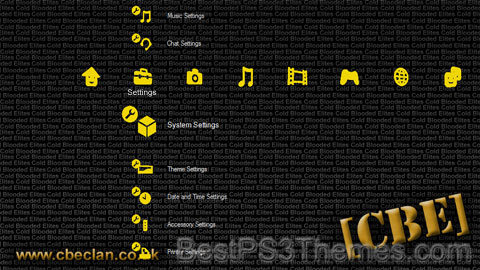
(1 background)
Copyright (c) 2007. Anoop Menon
p3textractor filename.p3t [destination path]Replace filename with the name of the p3t file, and replace [destination path] with the name of the folder you want the files to be extracted to. A destination path is not required. By default it will extract to extracted.filename.Ratchet and Clank #3
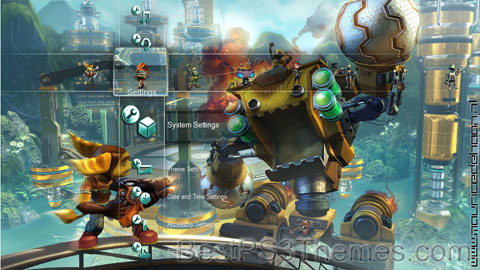
(2 backgrounds)
Grand Theft Auto IV #10
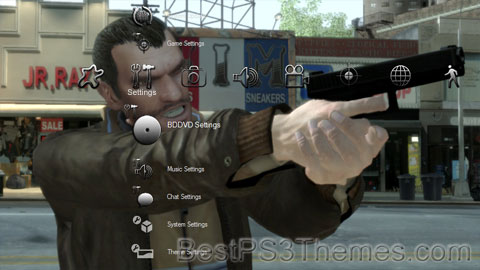
(5 backgrounds)
Grand Theft Auto IV 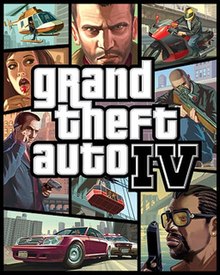
Developer(s) Rockstar North[a] Publisher(s) Rockstar Games Producer(s) Leslie Benzies Programmer(s) Artist(s) Aaron Garbut Writer(s) Composer(s) Michael Hunter Series Grand Theft Auto Engine RAGE Platform(s) Release PlayStation 3, Xbox 360 Genre(s) Action-adventure Mode(s) Single-player, multiplayer Gameplay[edit]

Synopsis[edit]
Setting[edit]
Plot[edit]
Development[edit]

Research and open world design[edit]
Story and character development[edit]
Art design[edit]
OSX
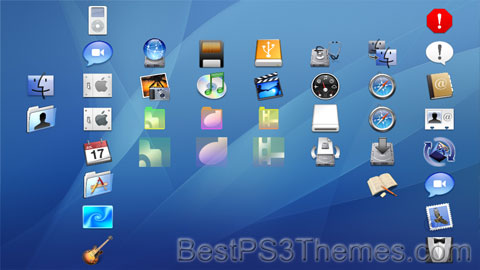
(1 background)
Blue Water